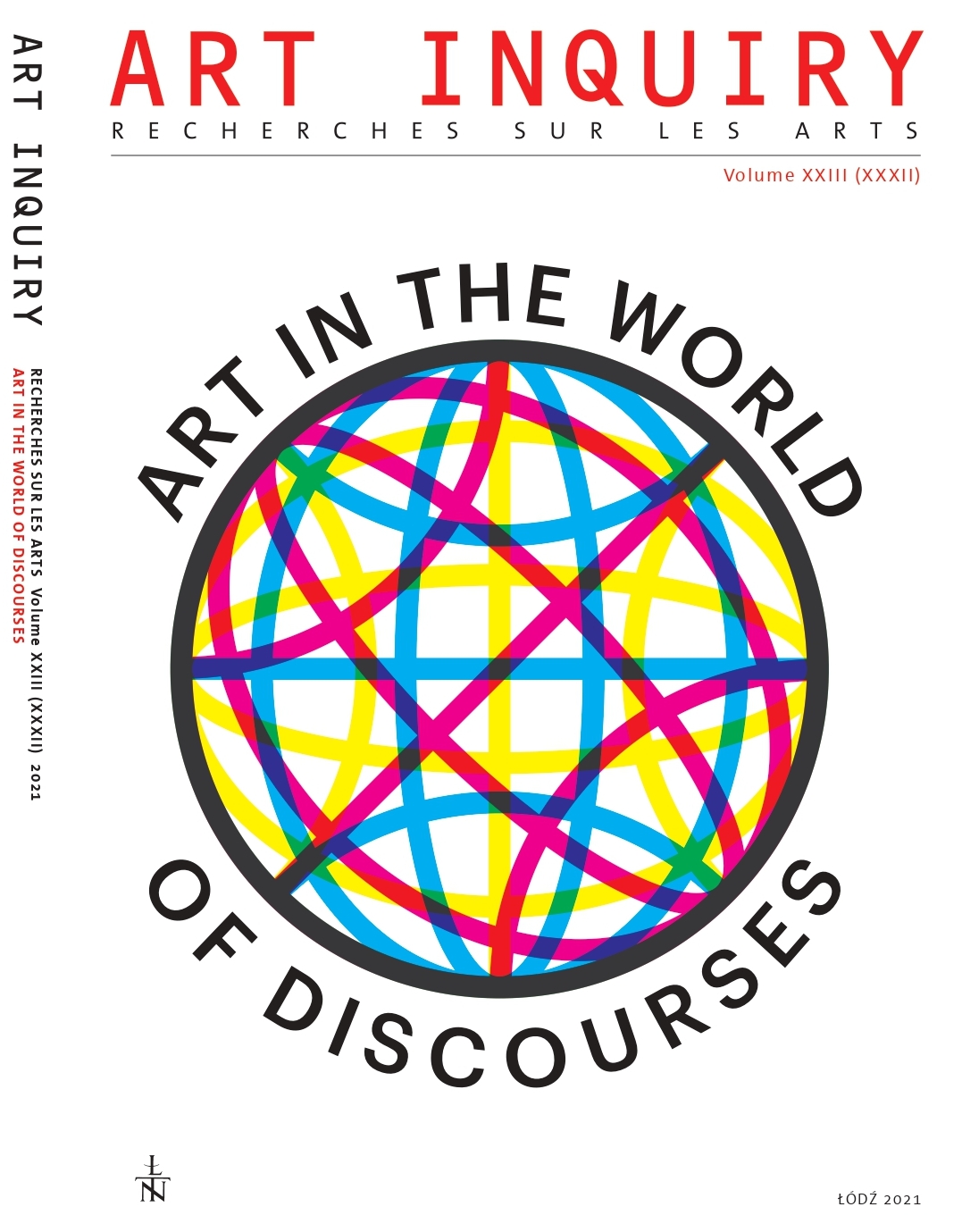Ecology and Art – in the network of discourses
DOI:
https://doi.org/10.26485/AI/2021/23/8Keywords:
art discourses, ecological discourse, eco-art, land artAbstract
Art, just like our public life, is entangled in the network of discourses. In this article, using the example of ecology-related art, I present how this network develops and what could constitute an impulse to create new connections. I also indicate how the discursivization of art begins with nomenclature itself. I consider reflecting on the network of discourses and entering the level of metadiscourse as a way of freeing oneself from the limiting community of interpretation. Similarly, I see the type of art that creates spaces for joint activities as a way out of the dangerous rivalry of discourses.
References
Bower Sam, A Profusion of terms, https://www.lindagass.com/PDFs/Unity_June09.3.pdf
Braddock Alan C., (2009), Ecocritical Art History, “American Art”, vol. 23, no. 2, pp. 24-28.
Czachur Waldemar, (2011), Dyskursywny obraz świata, “Tekst i dyskurs – text und diskurs”, no. 4, p. 79-97.
Czerwiński Maciej,(2005) Kultura, dyskurs, znak, Wyd. UJ, Kraków.
van Dijk Theo (2014), Discourse and Knowledge: A Sociocognitive Approach, Cambridge Univeristy Press, Cambridge
Discourse Studies: A Multidisciplinary Introduction (2011) Teun van Dijk Teun (ed.) second ed., Sage Publications, Los Angeles, London, New Delhi, Singapore, Washington.
Fish Stanley (2005), Is there a Text in this Class? The authority of interpretive communities, Cambridge: Harvard University Press.
Foucault Michel, (1981) The Order of Discourse, [in:] Untying the Text: A Post-structuralist Reader, (ed.) Robert Young, Routledge & Kegan Paul, Boston, London, Henley, pp. 51-78.
Grzelka Monika (2009), Dyskurs intelektualny ponad i pomiędzy. Wyd. UAM Poznań.
Guzek Łukasz, Grzegorz Sztabiński, [in:] Katalog Artystów, http://www.artysci-lodzkie.pl/pl/artysta/s/grzegorz-sztabinski/
Howarth David (2000), Discourse, Open University Press, Buckingham, Philadelphia.
Hymes Dell (2001), Foundations in Sociolinguistics: An Ethnographic Approach, Routledge, (reprint) London.
Jakimiak Agnieszka, Interview with Alice Creischer, Susanne Kriemann, Antje Majewski, [Nature Morte spectacle. Premiere: 7th November 2020, Teatr Powszechny in Warsaw], p. [4]; https://artmuseum.pl/public/upload/files/Nature-Morte.pdf
Kagan Sacha (2014), La pratique de l’art écologique, “Plasatik”, no. 4, https://plastik.univ-paris1.fr/la-pratique-de-lart-ecologique/ in English on-line: https://www.researchgate.net/publication/274719395
Kagan Sacha,(2013), Art and Sustainability: Connecting Patterns for a Culture of Complexity, Transcript, Bielefeld.
Kazimieska-Jerzyk Wioletta, (2012), Obraz a idea. Estetyczno-antropologiczne paradoksy sztuki konceptualnej (implikacje ikonoklastyczne). / Image and Idea. Aesthetic and Anthropological Paradoxes of Conceptual Art (Iconoclastic Implications), “Sztuka i dokumentacja”, no. 6, pp. 47-52.
Krueger Rob, (2018) Art, Social Change, and the Green City: A Rebuke of Green Metropolitanization, “RCC Perspectives”, no. 1, GREEN CITY: Explorations and Visions of Urban Sustainability, pp. 81-88.
Lister Rosi, (2003), What is Environmental Art? A strategy for re-cognition, orientation and implementation, “Co-Gen Magazine”, https://www.ecologicalart.org/cogmag20what.html
Luke Timothy W. (1992), Art and the Environmental Crisis: From Commodity Aesthetics to Ecology Aesthetics, “Art Journal", vol. 51, no. 2, pp. 72-76.
Marzec Sławomir,(2018) Krytyka jako (anty)istota dyskursu sztuki, [in:] Teresa Pękala (ed.), Dyskursy sztuki, dyskursy o sztuce, Wydawnictwo UMCS, Lublin 2018, pp. 59-68.
Mullet Dianna R. (2018), A General Critical Discourse Analysis Framework for Educational Research, “Journal of Advanced Academics”, vol. 29(2), pp. 116–142 .
Ostrowicki Michał, Teoria sytuacji estetycznej M. Gołaszewskiej jako fundament estetyki, http://www.sideymyoo.art.pl/old/Teoria_sytuacji_estetycznej.pdf
Pierotti Raymond, Wildcat Daniel (2000), Traditional Ecological Knowledge. The Third Alternative (Commentary), “Ecological Applications”, vol. 10, no. 5, pp. 1333-1340.
Pisarek Walery (2006), Słowa ważne i ważniejsze, “Przegląd Humanistyczny”, no. 3, pp. 11-20.
Roose Henk et al (2018), Trends in Contemporary Art Discourse: Using Topic Models to Analyze 25 years of Professional Art Criticism, “Cultural Sociology”, vol. 12(3), pp. 303-324.
Scott Emily Eliza, Swenson Kirsten (2015), Introduction. Contemporary Art and the Politics of Land Use, in: Critical Landscapes, ed. Emily Eliza Scott and Kirsten Swenson, University of California Press, Oakland.
Scruton Robert (2012), Green Philosophy: How to think seriously about the planet, Atlantic Books, London.
Stalpaert Christe (2018), This body is in danger! Ekologia, protesty i aktywizm w sztuce, “Didaskalia”, no. 143, pp. 21-29.
Sztabiński Grzegorz, (2003) Język sztuki a marzenie o komunikacji bezpośredniej, “Saeculum Christianum : pismo historyczno-społeczne” 2003, no.10/2, pp. 89-100.
Thebaut Nancy, Upper Elizabeth L. (2010), Earth Movers: Quaking Up Land Art's Forgotten Feminist History, “Bitch: A Feminist Response to Pop Culture”, no. 48, pp. 37-42.
Verwoert Jan (2008), The Boss: On the Unresolved Question of Authority in Joseph Beuys' Oeuvre and Public Image, "e-floux journal", December no.1, https://www.e-flux.com/journal/01/68485/the-boss-on-the-unresolved-question-of-authority-in-joseph-beuys-oeuvre-and-public-image/
Wallen Ruth (2012), Ecological Art: A Call for Visionary Intervention in a Time of Crisis “Leonardo”, vol. 45, No. 3, p. 238.
Wojtyniak-Dębińska Ewa (2008), Grzegorz Sztabiński [in:] G. Sztabiński et. al (eds.) Proper names in the art of Lodz. Contemporary painting, graphic arts, sculpture and intermedia, the Strzemiński Academy of Fine Arts in Łódź, 2008, p. 167.





